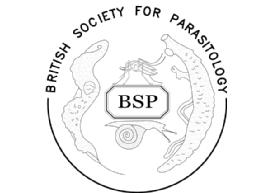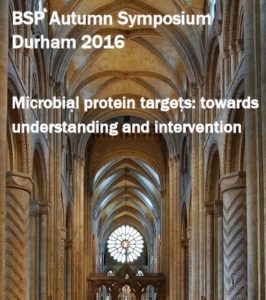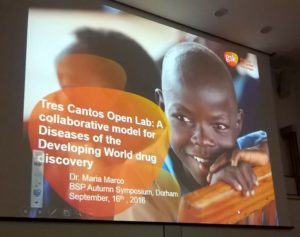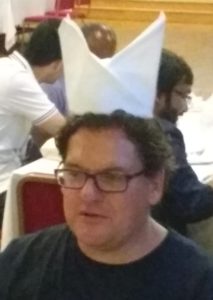
The British Society for Parasitology (BSP) hosts two annual meetings on a regular basis. The Spring Meeting, held in April, is a large, general parasitology meeting catering for the broad community. In contrast, the Autumn Symposium, held in September, is a smaller focused meeting allowing a subset of the community to discuss leading edge research and future directions within their research area.
This year, 2016, the BSP Autumn Symposium was hosted at Durham University with the title: Microbial Protein Targets: towards understanding and intervention. Staged in collaboration with the Royal Society of Chemistry (RSC) the core aim was to bring together the biological and physical sciences towards addressing target validation and inhibitor discovery in both protozoal and bacterial pathogens. By reaching out to the bacterial pathogen research community it is hoped that researchers could learn and develop novel approaches towards combatting infection and antimicrobial resistance.
As shown in the image top right, Durham is home to one of the finest examples of Norman architecture – the Cathedral. Unfortunately the Symposium was not held in this ecclesiastically finery, instead we took advantage of the more modern and high tech environment of the Calman Learning Centre on the University’s Science Site for a series of invited and selected talks and a poster session. In addition, and for the first time at a BSP meeting, a schools outreach session was held to dovetail with the Symposium. Approximately 100 GCSE and A level students were enthralled by Richard Bellamy (South Tees Hospitals) talking about the threat of antimicrobial resistance and Mike Barrett (University of Glasgow) provided powerful advocacy for the fight against Neglected Tropical Diseases (NTDs).
Given the history and focus of the BSP it was no surprise that many talks and posters were focused on protozoan parasites, particularly the Leishmania and Trypanosoma species that form part of the NTDs which have received increased focus in recent years. However, as intended, target discovery, validation and exploitation in some of the major bacterial pathogens, e.g. Clostridium difficile and Mycobacterium tuberculosis, was well represented.
Leishmaniais, and the difficulties in taking antiparasitic ‘hits’ forward towards clinical development, was the focus of the opening presentation. It was fitting that this was given by Simon Croft from the London School of Hygiene and Tropical Medicine. Not only because Simon has played the key role in bringing miltefosine, the only oral treatment for visceral leishmaniasis, to market, but also because he is a Durham graduate (1971). With the challenges in the development of antileishmanials, and antimicrobials in general, clearly mapped the Symposium programme then facilitated an exploration of target technologies, as well as rational to high throughput screening approaches to inhibitor identification.
With respect to target validation, Mike Barrett illustrated the comprehensive ‘omic-based methodologies his team have developed to retrospectively uncover the mode of action of antiparasitics. In a contrasting, forward, approach Gerald Spaeth (Institute Pasteur) explained the molecular approaches his laboratory is employing to validation kinases as antileishmanial targets, a theme that was also developed by Despina Smirlis (Hellenic Pasteur Institute). An alternative genetic strategy, utilizing the Cre recombinase approach newly adapted for Leishmania spp, was described by Andreas Damianou (University of York).
Full validation of a protein target requires chemical, in addition to genetic, validation. The Symposium gave a platform for those using these physical science technologies in bacterial pathogens, providing the opportunity for information exchange and technology development with the assembled protozoologists. For example, Joseph Ndieyira (UCL) took a biophysical approach to understand the interaction of antibiotics with the bacterial target; Jean Bertoldo (University of Cambridge) described a chemical editing approach targeting non-catalytic cysteine residues to investigate M. tuberculosis and Y. enterocolitica tyrosine phosphatases; and Ishwar Singh (University of Lincoln) told us how to improve the efficacy of moenomycin against resistant Gram negative bacteria. In a contracting chemical-biology approach it is notable that the genetic tractability of bacteria have been exploited in synthetic biology approaches to bioengineer potential antimicrobials against the problematic multidrug-resistant Gram-negative pathogens (Joleen Masschelein, University of Warwick).
Chemical biology approaches are also being developed and employed to identify and validate protein targets in the protozoa. For example, innovative fractionation technology to gain full functional understanding of the Trypanosoma brucei lysosome (Simon Young, University of St Andrews); chemical inhibition of an identified antitrypanosomal target (Sarah Oates, Keele University) or the development of invasion inhibitors (Marissa Maciej-Hulme, also Keele). Ed Tate (Imperial College), described his group’s use of innovative chemical tagging technology to study the role of myristoylation and the tractability of the associated enzyme, N-myristoyltransferase.
Ed’s work has moved molecules into the drug discovery space, the use of both rational and high throughput screening approaches were also discussed. Wim Hol (University of Washington, Seattle) introduced structure-based drug design from a crystallographer’s perspective, discussing his long-standing interest in trypanosomal tRNA synthetase. The use of structural approaches was also illustrated by Mike Webb (University of Leeds), Paula Salgado (University of Newcastle) and Martin McPhillie (also Leeds) to investigate bacterial pantothenate biosynthesis, C. difficile host interactions and to aid the discovery of anti-malarial agents.
In a reverse approach, Chris Abell FRS (University of Cambridge) described the rational scheme  employed by Astex Pharmaceuticals to discover new antituberculosis agents – starting with biochemical screening using a fragment library, ending with a protein structure-based approach. Whilst there has been a resurgence of interest in natural product-based antiparasitics (Bartira Rossi-Bergmann [UFRJ, Brazil]; Stefanie Menzies [St Andrews]), the primary drug discovery approach allied to these rational methodologies remains compound screening. Suzanne Lamotte (Institute Pasteur) described the use of a small, directed library of histone modifying enzyme inhibitors. In contrast the use of industrial ultra high throughput screening platforms to assay 1.8 million compounds at GSK Tres Cantos was presented by Maria Marco-Martin (see image above), as was the process to enter validated targets into the pipeline. Similarly, Mike Ferguson FRS discussed the work of the Dundee Drug Discovery Unit and its interactions with GSK Tres Cantos, as well as his own pivotal work on the Trypanosoma brucei cell surface, itself a source of multiple targets.
employed by Astex Pharmaceuticals to discover new antituberculosis agents – starting with biochemical screening using a fragment library, ending with a protein structure-based approach. Whilst there has been a resurgence of interest in natural product-based antiparasitics (Bartira Rossi-Bergmann [UFRJ, Brazil]; Stefanie Menzies [St Andrews]), the primary drug discovery approach allied to these rational methodologies remains compound screening. Suzanne Lamotte (Institute Pasteur) described the use of a small, directed library of histone modifying enzyme inhibitors. In contrast the use of industrial ultra high throughput screening platforms to assay 1.8 million compounds at GSK Tres Cantos was presented by Maria Marco-Martin (see image above), as was the process to enter validated targets into the pipeline. Similarly, Mike Ferguson FRS discussed the work of the Dundee Drug Discovery Unit and its interactions with GSK Tres Cantos, as well as his own pivotal work on the Trypanosoma brucei cell surface, itself a source of multiple targets.
 The Symposium was punctuated by a Gala Dinner in the grand surroundings of Durham Castle, where fun was had by all – see left (that’s me).
The Symposium was punctuated by a Gala Dinner in the grand surroundings of Durham Castle, where fun was had by all – see left (that’s me).
Most importantly, it is be hoped that the bringing together of researchers with interests in protozoan and bacterial pathogens, with respect to technologies from the biological to the physical sciences will have provoked new ways of thinking to address some of the most serious threats to human health.
Thanks goes to Durham University’s Biophysical Sciences and Wolfson Research Institutes, Cambridge University Press, GlaxoSmithKline and, of course, the Royal Society of Chemistry for their support of this Symposium.

Comments